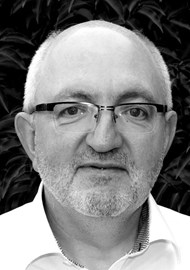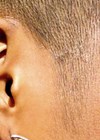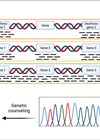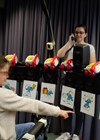Although there is high prevalence of late-onset, progressive, and acquired hearing losses during childhood, these hearing losses can easily go undetected due to the lack of systematic hearing screening beyond newborn hearing screening. In this article, the authors share the effectiveness of a newly developed school-entry hearing screening that can be used worldwide.
About two per 1000 children are born with hearing loss. Untreated hearing loss increases the risk for speech, language, and learning difficulties and low social-communicative abilities. Many countries have implemented neonatal hearing screening (NHS) programmes to ensure early detection and rehabilitation of congenital hearing loss, and in a third of these countries, more than 85% of newborns are screened.
However, the prevalence of hearing loss most likely doubles before the age of nine, and these late-onset, progressive, and acquired hearing losses are not detected with NHS [1]. Still, in most countries, no systematic hearing screening exists beyond NHS, meaning that these hearing losses can go unnoticed. As even mild hearing loss above 20 dB HL can affect educational achievements, there is high importance in implementing hearing screening programmes at later ages during childhood as well.
The few available school-age hearing screening programmes at this moment are often not able to detect hearing loss lower than 30-35 dB, mainly because they rely on pure-tone audiometry, which is only reliable under quiet acoustic conditions. Unfortunately, such conditions are often not readily available in school settings.
Speech-in-noise testing: a possible solution?
A possible solution is speech-in-noise (SPIN) testing because speech is presented in background noise at a level well above the hearing threshold of normal-hearing (NH) participants, making the results less sensitive to environmental noise. As poor speech understanding in noise is usually among the first complaints of hearing-impaired (HI) people, SPIN tests are highly sensitive to (mild) hearing losses.
"The DTT uses speech and is, therefore, language-dependent, meaning that for every language a new test version needs to be developed, which requires extensive developmental research"
In Flanders, the Dutch-speaking part of Belgium, SPIN screening has been successfully implemented for large-scale systematic hearing screening of children in the sixth grade of elementary school and the third grade of secondary school, meaning that every child in these school grades is offered a SPIN hearing screening done by school health services [2]. The test used is the Digit Triplet Test (DTT), an adaptive SPIN self-test on tablet, using combinations of three digits in the presence of background noise (see Figure 1) [3].
 Figure 1. Interface of the DTT (left) and the SEC (right).
Figure 1. Interface of the DTT (left) and the SEC (right).
A large validity study on the implementation of the DTT as a systematic school-age hearing screening showed that results could be estimated with high within-measurement reliability in only around five minutes. With grade-specific pass/fail criteria set at the 95th percentile, in 30-50% of the referred children elevated pure-tone thresholds were detected during follow-up diagnostic investigations. Hearing losses found were mostly mild. These results indicate easy implementation, high reliability, and fair diagnostic accuracy, which are key features of a qualitative screening test.
The need for an international standard for school-entry hearing screening
The World Health Organization (WHO) and the European Federation of Audiology Sciences (EFAS) strongly recommend screening all children for hearing loss and ear diseases at school entry (five to six years old) as a bare minimum. The DTT has been proven too difficult for children at school entry, for example, because children need to know the digits and their written forms, and therefore, a large portion of these children cannot obtain reliable test results. Consequently, the DTT is not optimal for providing screening at school entry, and research needs to be done towards a more suitable test for these younger children.
"The SEC was validated in three different countries, showing no cultural effects on the norm values and the familiarity of the sounds"
Moreover, a language-independent task would greatly benefit an international school-entry hearing screening test. The DTT uses speech and is, therefore, language-dependent, meaning that for every language a new test version needs to be developed, which requires extensive developmental research. A language-independent screening test that, for example, uses sounds instead of speech would directly solve this problem and make wider, across-country implementation possible.
The Sound Ear Check: a language-independent hearing screening test for young children
The Sound Ear Check (SEC) is such a language-independent test [4,5]. It is an automated adaptive closed-set self-test on a tablet (Figure 1). It is based on the perception of sounds, such as the barking of a dog or the honking of a car, presented in spectrally matched background noise. The sounds cover the frequency range most important for speech understanding (500–4000 Hz) and have similar temporal and spectral features as natural speech.
"Together with the optimisations done on the sound and noise material, only 5% of the children obtained unreliable results"
The SEC was validated in three different countries, showing no cultural effects on the norm values and the familiarity of the sounds. Receiver operating characteristic (ROC) curve analysis showed sensitivity and specificity rates of 70-90% to detect young children with conductive and sensorineural hearing loss. However, the original SEC took approximately six minutes, and 17% of the children could not obtain a reliable result, probably due to motivation and attention loss [5].Therefore, the SEC was optimised and combined with two new test procedures. The first procedure used a fixed signal-to-noise ratio (SNR), i.e. the same SNR for all stimulus presentations, and a stopping rule based on the number of correct answers implemented to shorten the test duration.
The SNR used was equal to the optimal cutoff value for differentiating between NH and HI children, determined with ROC analysis. The other procedure presented sounds antiphasically in phasic noise, introducing an antiphasic advantage larger for NH listeners than HI listeners, making it possible to detect all types of (asymmetric) hearing loss even when screening binaural. Both procedures could reduce the test duration to three to four minutes without decreasing the test-retest reliability. Moreover, together with the optimisations done on the sound and noise material, only 5% of the children obtained unreliable results [5]. Taken together, the SEC and its new test procedures have great potential to be used as an international, school-entry hearing screening test.
Ongoing research
At this moment, the sensitivity and specificity of the new SEC procedures are being researched, ensuring the high sensitivity and specificity of the original version are maintained. This research is done in multiple countries, allowing for a broader investigation of cultural effects. With this research, we aim to take another step towards developing an internationally applicable self-test for a school-entry hearing screening.
References
1. Fortnum HM, Summerfield AQ, Marshall DH, et al. Prevalence of permanent childhood hearing impairment in the United Kingdom and implications for universal neonatal hearing screening: questionnaire based ascertainment study. BMJ 2001;323(7312):536-40.
2. Denys S, Hofmann M, Luts H, et al. School-Age Hearing Screening Based on Speech-in-Noise Perception Using the Digit Triplet Test. Ear Hear 2018;39(6):1104-15.
3. Van den Borre E, Denys S, Van Wieringen A, Wouters J. The digit triplet test: a scoping review. Int J Audiol 2021;60(12):946-63.
4. Denys S, de Laat J, Dreschler W, et al. Language-Independent Hearing Screening Based on Masked Recognition of Ecological Sounds. Trends Hear 2019;23:1-16.
5. Van den Borre E, Denys S, Zupan L, de Laat JAPM, et al. Language-Independent Hearing Screening – Increasing the Feasibility of a Hearing Screening Self-Test at School-Entry. Trends Hear 2022;26:1-15.













